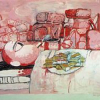Philip Guston

Philip Guston
Philip Guston, born Phillip Goldstein, was a painter and printmaker in the New York School, which included many of the abstract expressionists, such as Jackson Pollock and Willem de Kooning. In the late 1960s Guston helped to lead a transition from abstract expressionism to neo-expressionism in painting, abandoning the so-called "pure abstraction" of abstract expressionism in favor of more cartoonish renderings of various personal symbols and objects...
NationalityAmerican
ProfessionPainter
Date of Birth27 June 1913
CountryUnited States of America
It is possible to make a living thing, not a diagram of what I have been thinking: to posit with paint something living, something that changes each day.
Painting seems like impossibility, with only a sign now and then of its own light.
I'm not interested in painting; I'm not interested in making a picture. Then what the hell am I interested in? I must be interested in this process.
More than a process, painting is being possessed...
In my experience a painting is not made with colors and paint at all. I don't know what a painting is; who knows what sets off even the desire to paint?
When I see people making 'abstract' painting, I think it's just a dialogue and a dialogue isn't enough. That is to say, there is you painting and this canvas. I think there has to be a third thing; it has to be a trialogue.
There is something mysterious in this work that I do not ever what to discover.
I should like to paint like an man who has never seen a painting, but this man -myself - lives in a museum.
To paint is a possessing rather than a picturing.
What is seen and called the picture is what remains - an evidence. Even as one travels in painting toward a state of 'unfreedom' where only certain things can happen, unaccountably the unknown and free must appear.
To paint is always to start at the beginning again, yet being unable to avoid the familiar arguments about what you see yourself painting.
Look at any inspired painting. It's like a gong sounding; it puts you in a state of reverberation.
Studio Ghosts: When you're in the studio painting, there are a lot of people in there with you - your teachers, friends, painters from history, critics... and one by one if you're really painting, they walk out. And if you're really painting YOU walk out.
Painting is an illusion, a piece of magic, so what you see is not what you see.